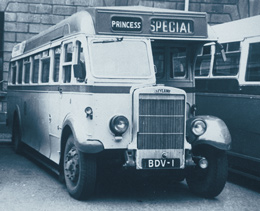|
 |
Modern Irish jargonauts seem incapable of speaking or writing without making a reference to the Celtic Tiger. It has probably never occurred to them that a physical manifestation of this beast really exists - it is alive and well in Howth, where its throaty purr can be heard regularly. The Tiger in question is a very important Leyland bus - what else? - in the Transport Museum.
The very first Leyland Tiger ever built, in 1927, became No. 400 in the fleet of the Irish Omnibus Company, later absorbed by the Great Southern Railways. The GSR became part of CIE in 1945 and Bus Éireann, set up in 1987, is today's striking reincarnation of the highly respected IOC. The IOC's No. 400 was the precursor of several hundred Tigers that gave faithful service all over Ireland for more than forty-five years, providing much of the early infrastructure on which our society depends. No. 400, fondly known as Tiger Tim, the prototype TS1 model, was petrol-engined, as were most of its successors up to World War Two, by which time the marks had reached TS11, an 8.6-litre diesel model with no petrol option. Pre-war Leyland Tiger diesels, which became more numerous during the late 1930s, were unpopular with bus crews, especially the drivers, who preferred the petrol equivalents. They especially disliked some further T class Tigers of the TS11 type which entered CIE service in 1947, but their attitude changed dramatically in 1948 with the arrival of the first of the P class.
Leyland's powerful 9.8-litre O.600 engine, driving through a four-speed synchromesh gearbox, made the new P class of PS series Tigers easy to drive and well capable of keeping up with their petrol-engined stablemates. CIE chose them for an urgent programme to replace most of their pre-war single-deckers - more than two hundred petrol-engined buses and coaches, plus about a hundred and twenty four-cylinder diesels. Over a three-year period beginning in mid-1948, two hundred and ninety OPS3 Tigers entered service. At 30' 0" (9.1m), these P class vehicles, 2' 6" (0.72m) longer than their predecessors, enabled the seating capacity of a service bus to be increased from 32 or 36 to 39.
All P class Tigers had bodywork constructed at Spa Road, country buses, coaches and urban buses all sharing the same standard body frame. At 8' 0" (2.43m), P class buses and coaches were also 6" (150mm) wider than the older buses, thus proving a worry to local authorities responsible for the West of Ireland's notoriously inadequate roads. The result, in 1953, was the construction of seventy-one narrow PS2 type buses, P291-361, but which were otherwise similar to the wider models. With the completion of the replacement programme, the highly distinctive P class bus became an integral part of the scene, urban and rural, over much of Ireland for nearly twenty eventful years. These were the decades that witnessed the extension of rural electrification, the introduction of television, farm mechanisation and the inauguration of the school transport system.
On 1st October 1953, the 39-seater Tiger P347 (ZO 6857) entered service at Ballina Garage, working for several years on the Louisburgh route. It then spent some time in Donegal, later migrating to Athlone, where it last worked stage services in 1967. This bus next went to Drumcar in Co. Louth where it served as school transport, being finally withdrawn in 1980. The following year it came into the Transport Museum collection where it began yet another existence, its career as an important exhibit being punctuated by several film roles. So far, P347 has chalked up more than a dozen film appearances, including The Country Girls, Eagles and Trumpets and, most recently, Circle of Friends.
The fascination of a preserved vehicle increases in proportion to its variance with the world into which it has survived. P347 is no exception, recalling as it does a vanished Ireland for which so many people still yearn. But do we really want those times back? Time and distance may lend enchantment, but in the so-called good old days we endured unemployment, poverty, emigration - among many other things now thankfully behind us. The real importance of P347 and its companions in preservation is as memorials to the countless people who made the sacrifices that culminated in our comparatively comfortable lifestyles.
Strangely, by the time P347 went to work in 1953, it was already obsolete. The first commercially available underfloor-engined buses had appeared in 1950; a Leyland Royal Tiger demonstrator with this mechanical layout visited CIE in 1951, and the Great Northern Railway bought their first four underfloor-engined buses in 1952. By 1954, CIE had committed itself to the Royal Tiger and it was obsolescence rather than wear and tear that eventually saw off the vertical-engined Tiger. However, this did not happen overnight: P class buses were still at work until 1972 and the introduction of the school bus network in 1967 brought into the CIE fleet fifty Tigers from another great Irish transport tradition which I hope to deal with in a later article.
Independent operators throughout Ireland also used the Leyland Tiger extensively over the years. Indeed such a vehicle, BDV 1, one of many second-hand imports from the United Kingdom, had clocked up a record 33 years' service when it was withdrawn by Princess of Clonmel in 1969. The impact of the Leyland Tiger on the development of our public transport system has simply never been appreciated.
|
|